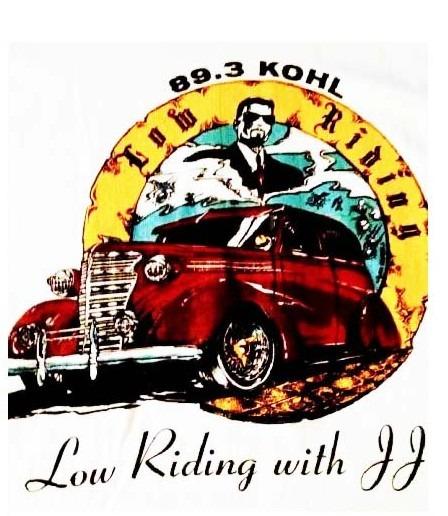Low Riding with JJ, Tuesdays 6-8pm.
By David John Chávez
The lore of a small East Bay town can be found within the Peter Mendoza Sports Complex in Union City any weeknight or Saturday from March through June. Five baseball fields, three which come in a little league size, sit on the Decoto side of town, east of the 880 freeway heading towards Mission Boulevard, a long drag that connects Hayward and Fremont to Union City and beyond.
Until 1959, Union City was two distinct towns—Decoto to the east, Alvarado bumping up against the 880 Freeway. The incorporating of towns is linked to the most consistent aspect of Union City—the high school, James Logan, founded the same year as Union City’s incorporation, named after an Irish man who owned plenty of land in the East Bay Area.
Looking past the mighty mites that fill the fenced-in diamond that doubles as Logan’s girls’ softball field, you’ll find a man who umpires the base paths for Union City National Little League, doing that job easily for more than 40 years. Jessie Amaya is now in his 80s and no longer handles home plate duties, but still scampers around the base paths while kids as young as nine slide into third and face judgement from the legendary arbiter.
Little league umpires are famously volunteers, although nowadays at Union City National, the home plate umpire gets a small fee for the trouble of having a parent shout out that they know more. Back in the mid-1980s, a group of little league moms who called themselves the “Women’s Auxilary” ran a robust snack bar. Hot dogs, nachos, and the “Frito Bandito,” a fancy yet slightly racist name for nachos with chili beans, all were served to legions of little leaguers and hungry parents—baseball Saturdays in Decoto were all day affairs.
In lieu of umpires getting paid for their troubles, a free hot dog and coke doubled as a quick meal and a direct deposit into the gut. Two games umpired got even better compensation. Two hot dogs, two cokes. Three games got the triple dog/drink combo. Four games, five games, there is clearly a pattern here.
The virtues of giving oneself was a way of life for a man who still finds a panacea on a tiny diamond. Those virtues were passed on to his son J.J., who spins Chicano oldies once a week for the East Bay via KOHL, a tiny radio station south of Union City at Ohlone College, housed in the larger city of Fremont.
For more than 42 years, two hours a week, the Union City native has doled out tunes for the community.
Turns out there are not even hot dogs and cokes at the local community college radio studio after volunteering to play music.
Today, you can hear “Lowriding with J.J.” via the livestream on Ohlone College’s radio station site, as well as 89.3 on the FM Dial. The station itself, which is a fraction of a larger Bay Area radio station at only five watts, got a huge signal boost in the way of worldwide streaming during the internet era, a platform that Amaya relishes completely.
A life on the radio was never the aim when Amaya was approaching the back end of his teenage years. In the summer of ‘79, an 18-year-old Amaya began working for a local drug program as a youth coordinator. His work ethic stood out to the program’s director, who was spending time at Ohlone College’s radio station himself, disc jockeying a Mexican music format when he was away from the drug program. But it became unsustainable due to his schedule, which prompted the director to call Amaya into his office.
“He asked if I would be interested in taking the show over, and I said I think I would like that,” said Amaya. “Not long after that, he took me to the station a few times, showed me the ropes, and then let me sink or swim.”
For a brief spell, Amaya followed the format implemented prior to his arrival, but found out very quickly that, while he loved traditional Mexican music, the set of songs from iconic Mexican crooners like Vicente Fernandez, Javier Solis, Lola Beltran and Antonio Aguilar were more apropos for his parents’ first-generation demographic. Wax purveyors such as Thump Records, who published the 12-volume collection “East Side Story” in 1978 and the Black soul stars that lived on the Stax/Volt label had more of his vibe.
Lowriding was coming into its own as a specific subculture, and Union City acquired some legendary status with its very popular Lowrider Happenings that ran for five years. Larry Orozco, himself a Union City institution (The Teen Workshop on Mission Boulevard was named after him in 2018, Amaya emceeing the large community event) founded the Happening in 1979, inspired in part by a desire to quell tensions between brown youth and the city’s police force. The burgeoning Chicano culture included lowrider cars and bikes and the incredibly popular Lowrider Magazine, which was published for the first time in 1977 by a trio of San José State students.
The era ushered in a firm commitment to a whole new fashion for brown kids everywhere. The second generation of Mexicans , no longer satisfied to just be part of the country, were more than ready to leave their stamp on a new brand of popular culture. The zeitgeist of the time made for the perfect moment for fresh-faced Amaya to move his fledgling audience in a whole new direction.
Amaya had a brief tenure as a student at Ohlone, and like many of the Latino kids on campus, befriended a sage librarian named Jim Landavazo. Amaya would pop in often to chit-chat with Landavazo, and bounced an idea off him.
“One day, I talked to Jim and said, ‘I’d like to do some oldies on the radio instead of all the Mexican music.’ And he told me. ‘J.J., that’s our time on the radio—if that’s what you want to do, you do it and I’ll back you up.’”
Landavazo’s offer of backup was a very specific one—he was ready to defend Amaya from anyone who might be looking for a way to shut down the change in formats. But what Amaya didn’t fully account for was the affirming energy that awaited his show. Baby boomers and their kids, who grew up on a steady diet of Thee Midniters, Tierra, War and the Delfonics spun by disc jockeys such as Huggy Boy, Wolfman Jack and Art Laboe, now had one of their very own who grew up among them in Decoto. The decision to change formats was a boon for the station, and made the three words “Lowriding with J.J.” into an East Bay household institution.
“Immediately after about the first six weeks, I started receiving mail on campus, and no disc jockey there had ever received mail before,” recalled Amaya. “I was averaging about 25 letters a week from listeners who wanted dedications and requests, and the station manager at the time was floored. He could not believe what was happening.”
In those early days, the show was pre-recorded. But once the show went live, all bets were off.
“The first day, the phones went berserk, and the station manager told me that if I was going to do a live radio show, we needed someone to handle the phones.”

Amaya didn’t know how much this gig would consume his life when he was just a teenager, but at age 61, he is still going strong. His love for radio and noble, volunteer spirit was born from a young man and others of his generation figuring out their way in the world.
“It became a very fun time for the community. There was such a following for the music because it was such a way of life. For all of us in that age group, we were desperately searching for something to call our own, and this show just picked up steam and started rolling.”
One place where the show hit its target was with teenage girls, who found out quickly that Amaya was willing to use his platform to get their voices heard.
“We were getting live phone calls, and there would be 10 people in a house and they would pass the phone around. It was funny because they were basically saying the same dedication to everyone that the previous person just mentioned. It was repetitive, but nonetheless, it was a lot of fun.”
“J.J.’s show really allowed the community to network together in different areas where he would promote different community events, as well as having guest speakers on his show,” said Orozco, who spent 36 years working for Union City’s leisure services department until his retirement in 2010. “His thrust of promoting education was important as well.”
Having a platform like the Lowrider Happening, where both he and Orozco were able to provide a powerful voice for a distinctly Chicano subculture, the Happenings taking place at Union City’s city hall, with the radio show going all year long, continued Amaya’s amplification.
Unfortunately, not everyone in the community was ready to embrace this newfound expression of freedom and brown pride. Flipped up baseball cap bills, white tank tops, baggy khakis and black derby jackets with “Chicano Power” emblazoned on the back were not always looked at in the most positive of lights. Expression that comes with being brown in the early ‘80s had plenty of detractors.

“Lowriding was taking off big, a lot of car clubs were coming out at the time, and I tried to keep a positive image because we couldn’t get lost in the fact that the media generalizes lowriders with gangs,” recalled Amaya. “If you were driving a lowrider, you were automatically associated with the negative side of our demographic, and that was really, really sad. So many people who started this lifestyle ended up with high traffic fines, citations – just ridiculous reasons. Everyone dealt with some type of harassment at some level.”
A specific level, separate from community service, that the Amaya family dealt with in the late 1990s was inhumane, a horrific incident hitting them hard in a very personal way. Amaya’s sister Lucilla was 35 years old in 1998, and in the early morning of March 7, the family feared she was ready to harm herself, and called the police to their home. According to the San Francisco Chronicle, an officer showed up and found Lucilla, who was under the influence of methamphetamine, wielding a knife in front of the house. When Lucilla began to move back into the house, the officer, Todd Woodward, shot five bullets through the screen door—two bullets hit her in the back, one landing in her left hip. She died five hours later at Eden Medical Center in Castro Valley.
A settlement for more than $1.8 million was settled in 2001, the largest portion going to Lucilla’s daughter, who was 18 when the incident took place. While Amaya told the Chronicle at the time that the family was happy with the accountability, there was a fissure between him and the city he loved. He also knew that, based on his status in the community, eyes were on him. He had a microphone, but knew he couldn’t use it the way he might have wanted.
“I had to separate having the platform to whatever I wanted to say, because I had to be professional first. In that sense I was there to do a radio show and to be an entertainer, not to subject my audience to what occurred. I never lost sight of that. I would put out disclaimers that my views did not reflect KOHL or Ohlone College, and the staff would tell me if they felt I might have gone a little beyond their acceptance. We always kept things professional and I didn’t try to cross that line.”
Despite the settlement and the years that have passed, Amaya still feels reticence to engage with the city on a deeper level—the scars run too cavernously.
“At one time, I aspired to be on city council, but because of what happened, I lost all my desire to be in any type of public office.”
Amaya developed serious disenchantment with most of public life, and decided he wanted no part of it.
“I saw too many people not doing the right thing, and I just said I couldn’t do that. That’s not who I am.”
Nowadays, there are minimal signs of slowing down. He still loves the radio, loves the format, and loves keeping a relic of Chicano culture preserved. The music is still timeless, telling the tales of brown passion and reverence for a generation coming into their own in the late 1970s and beyond. Amaya does deal with a stiff back from time to time, which might throw him off the dial some weeks, but the voice of a generation has no desire of calling it a career just yet. If people and music be the food of love, Amaya plans to play on.
Amaya has worn a lot of hats: counselor, provider and compadre are just a few of the titles associated with the venerable spin doctor. When it comes to connecting with the community, those who might be down and out trying to survive in blue collar Decoto, still its own enclave, always has a friend in the esteemed disc jockey—a man with an oldie and an anecdote at his fingertips. Quite literally, Amaya grew up in front of his community and is one of them who has laughed with them, cried with them.
The soundtrack Amaya spins is the heartbeat of a community, taking many through the joys and devastation of East Bay living. Just like his dad, Amaya makes sure he calls people safe as often as he can. At the very least, it’s something he is able to do every Tuesday evening, five watts and one Chicano oldie at a time.
Listen to “Lowriding With J.J.” Tuesday nights from 6 to 8 pm online.

![]()
![]()
![]()
![]()
![]()







